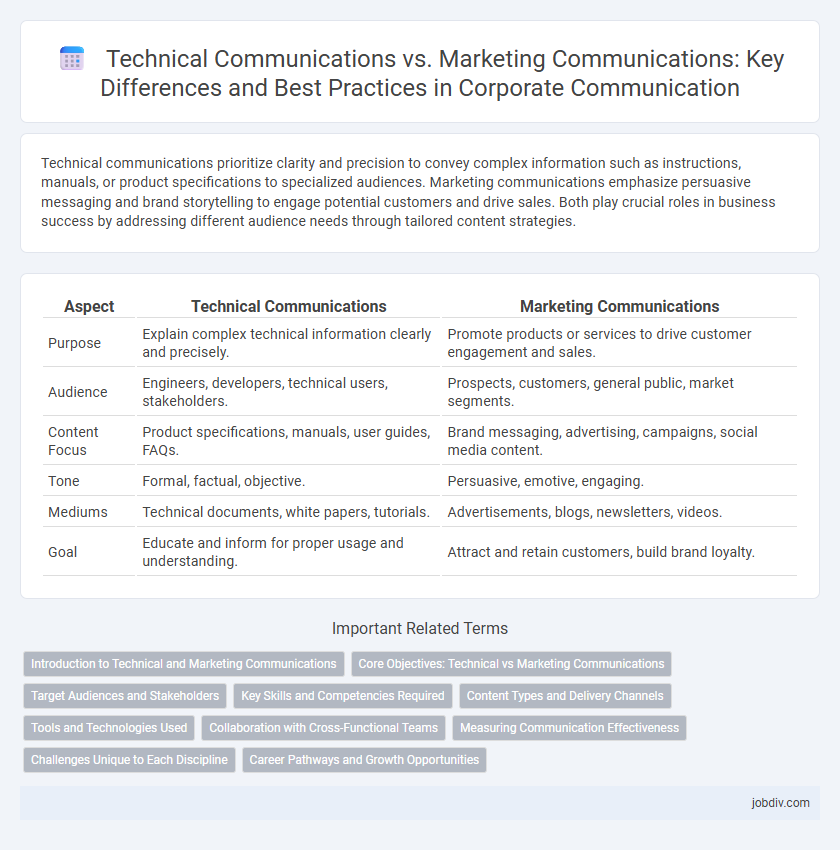Technical communications prioritize clarity and precision to convey complex information such as instructions, manuals, or product specifications to specialized audiences. Marketing communications emphasize persuasive messaging and brand storytelling to engage potential customers and drive sales. Both play crucial roles in business success by addressing different audience needs through tailored content strategies.
Table of Comparison
| Aspect | Technical Communications | Marketing Communications |
|---|---|---|
| Purpose | Explain complex technical information clearly and precisely. | Promote products or services to drive customer engagement and sales. |
| Audience | Engineers, developers, technical users, stakeholders. | Prospects, customers, general public, market segments. |
| Content Focus | Product specifications, manuals, user guides, FAQs. | Brand messaging, advertising, campaigns, social media content. |
| Tone | Formal, factual, objective. | Persuasive, emotive, engaging. |
| Mediums | Technical documents, white papers, tutorials. | Advertisements, blogs, newsletters, videos. |
| Goal | Educate and inform for proper usage and understanding. | Attract and retain customers, build brand loyalty. |
Introduction to Technical and Marketing Communications
Technical communications focus on delivering precise, clear, and concise information about complex products, processes, or systems to enable user comprehension and effective decision-making. Marketing communications aim to engage target audiences by promoting products or services, emphasizing brand value and customer benefits through persuasive messaging. Both disciplines utilize tailored language and formats to achieve distinct objectives--technical accuracy versus emotional appeal--within organizational communication strategies.
Core Objectives: Technical vs Marketing Communications
Technical communications focus on delivering precise, clear information about products, processes, or systems to enable understanding and proper usage by specialized audiences. Marketing communications aim to engage potential customers, build brand awareness, and drive sales through persuasive messaging and storytelling. The core objective of technical communication is clarity and accuracy, while marketing communication prioritizes influence and emotional appeal.
Target Audiences and Stakeholders
Technical communications primarily target specialized audiences such as engineers, developers, and technical stakeholders who require precise, detailed information to understand complex products or systems. Marketing communications focus on broader audiences including potential customers, partners, and general consumers, aiming to persuade and promote brand value through engaging and accessible messaging. Understanding the distinct needs of these target audiences ensures effective communication strategies tailored to the stakeholders' objectives and comprehension levels.
Key Skills and Competencies Required
Technical communications demand strong analytical abilities, proficiency in specialized software, and expertise in accurately conveying complex information to technical and non-technical audiences. Marketing communications require creativity, strategic thinking, and skills in persuasive writing, branding, and audience engagement across multiple channels. Both fields prioritize excellent written communication, adaptability, and an understanding of audience needs to effectively deliver targeted messages.
Content Types and Delivery Channels
Technical communications focus on detailed, precise content such as manuals, user guides, and product specifications, delivered through channels like intranets, email, and knowledge bases tailored for technical audiences. Marketing communications prioritize persuasive and engaging content including advertisements, social media posts, and promotional emails, distributed via mass media, social platforms, and targeted email campaigns to drive brand awareness and customer engagement. Both content types leverage digital platforms but differ fundamentally in purpose, tone, and audience targeting.
Tools and Technologies Used
Technical communications employ tools such as XML editors, content management systems (CMS), and single-source publishing platforms to produce precise and reusable documentation. Marketing communications leverage customer relationship management (CRM) software, social media platforms, email marketing tools, and analytics solutions to engage target audiences and measure campaign effectiveness. Both fields increasingly utilize AI-driven technologies for content creation, personalization, and distribution, enhancing efficiency and impact.
Collaboration with Cross-Functional Teams
Technical communications require precise collaboration with engineering, product development, and quality assurance teams to ensure accuracy and clarity in complex information. Marketing communications depend on partnerships with creative, sales, and market research teams to craft persuasive messages that resonate with target audiences. Effective collaboration between these departments enhances overall brand messaging and streamlines the customer experience.
Measuring Communication Effectiveness
Technical communications effectiveness is measured by comprehension rates, task completion accuracy, and reduction in support queries, reflecting how well specialized information is conveyed. Marketing communications effectiveness relies on metrics like conversion rates, click-through rates, and brand engagement, highlighting consumer response and ROI. Both require tailored analytics to ensure messages meet their distinct goals within communication strategies.
Challenges Unique to Each Discipline
Technical communications face challenges in accurately conveying complex information to diverse audiences while maintaining clarity and precision. Marketing communications must balance creativity with brand consistency, aiming to engage and persuade target customers effectively. Each discipline requires specialized skills to address audience expectations, with technical communication focusing on detailed documentation and marketing emphasizing emotional resonance.
Career Pathways and Growth Opportunities
Technical communications careers emphasize skills in creating clear, detailed documentation for engineering, IT, and scientific fields, often leading to specialized roles such as technical writer, documentation manager, or information developer. Marketing communications professionals develop brand messaging, digital campaigns, and content strategy, driving growth into roles like content strategist, marketing manager, or brand director. Growth opportunities in technical communications typically involve advancing through complex product knowledge and industry certifications, while marketing communications careers benefit from expanding expertise in market analytics, consumer behavior, and creative leadership.
Technical Communications vs Marketing Communications Infographic

 jobdiv.com
jobdiv.com